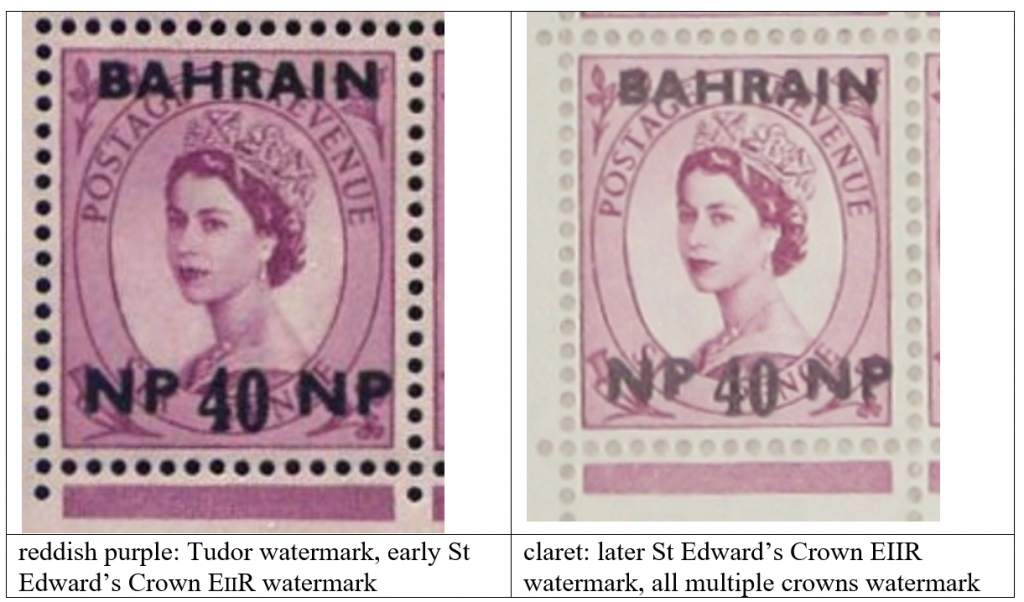1. Acknowledgements by the author Dr. John Gledhill
Dr John Gledhill was in the process of compiling his ‘GB Overprint Compendium’ on behalf of the GB Overprints Society into a formal publication. The information that John compiled over a number of years remains a much valued resource for society members but sadly, due to health issues, John has found that the burden of this task was too great but has kindly allowed the society to use much of the content in this website for the benefit of members and hopefully potential new members.
This work which has been split into the ‘Postal Agencies’ was the combined effort of a number of renowned philatelists and companies but a special thank you is expressed to Mike Osborne, Harvey Russell, Mike Sanders, Geoff Chivers, Barry Cousins, Francis Kiddle, Mike Phelan, Tony Stanford and Bill Tyson for information on their collections and for the numerous scans of cylinders and controls which they submitted; to other members who have sent scans of particular items. And to Barrie Cook who, at the start of the research for this book, searched out so many useful documents and books from the society’s library. This research could not have been done without them.
Particular thanks also go to Stanley Gibbons Ltd, for permission to quote their catalogue numbers, and to Warwick & Warwick auctions for permission to include many illustrations from the Rossi auction 2005, especially for the Oil Rivers provisionals.
Contributors to this content include:
James Bendon, Tony Bishop, Paul Boniface, Keith Buckingham, Simon Burke, Geoff Chivers, Barry Cousins, Tom Current, John Davies, Robin Davis, Michael Deverell, Ken Dixon, Steve Ellis, Jürgen Endemann, Larry Gardner, Murray Gellatly, Brian Hurst, Thomas Johansen, Francis Kiddle, David MacDonnell, Alan Macgregor, Richard Malim, Mike Osborne, Mike Phelan, Harvey Russell, Mike Sanders, Tony Stanford, Bob Stein, Paul Stephens, Morris Taber, Martin Taylor, Alan Tregurtha, Bill Tyson, Marius Wlodarczyk
We apologise to any people whose names have been omitted from this list.
Thanks for use of some of their data are extended to the following dealers and societies for use images of their items:
David Allen, Anglo-American Appraisal, Argyll Etkin, Barefoot Ltd (revenues), Brian Bayford, Mark Bloxham, David Brandon, Bridger & Kay Ltd, Cavendish Auctions, Chris Ceremuga, Collectio auctions, Embassy Stamps, Stanley Gibbons Ltd, Grosvenors Philatelic auctions, Aron R Halberstam Philatelists Ltd, Hibernian Stamp Company, Ireland Stamps, David Loffstadt, MacDonnell Whyte Ltd, Duncan Murchie, Murray Payne Ltd, Muscotts, Principality Auctions, Raven Stamps, Rockstamps, Rodgau Philatelie, Ruby Stamps, Sandafayre Ltd, Silver Jubilee Stamps Study Circle, Sotheby’s auctions, Spink auctions, Status-International, Universal Philatelic Auctions (UPA), Andrew Vaughan, Warwick & Warwick (Rossi auction 2005)
2. Copyright
Copyright of images from 3rd parties (including those listed above) remains with them.
We are grateful to Stanley Gibbons Ltd for permission to quote their catalogue numbers in the tables above (if their catalogue includes several variations, eg shades, only the main number is given here); these numbers are © copyright Stanley Gibbons Ltd. Readers should, however, bear in mind that catalogue numbers may change over time, and in some cases the catalogue numbers cited here may not remain unchanged; a particular instance is the renumbering of some Irish overprints in subsequent editions of Gibbons catalogues to enable them to add new varieties.
The numbering system used in this book was devised by GBOS specifically for this publication and the Society’s web page, and is © copyright; the numbers may be cited provided acknowledgment is given. However their main use is to give a unique identified to each item to facilitate references rather than to be carved in stone for eternity: the allocated numbers may change if further editions of this book are published. All other information is covered by the copyright on the book itself, but may be freely quoted for research purposes provided acknowledgment is given. Reproduction for other purposes is not permitted without written consent of GBOS. Except where otherwise stated all stamp images were kindly provided by members of the GBOS.
3. Matters affecting more than one country
This section covers some points which affect more than one chapter and which would therefore need to be repeated several times.
3.1 King George V 2d dies
During the currency of the script cipher watermark on King George V issues, a new die was introduced for the 2d stamp. The key difference is that on die I the inner frame line is near to the central design, in die II it is in the middle of the white gap; there are also differences in the shading above the King’s head, where die II has more colour in the top line just below the wreath.
3.2 Seahorse types
Three printers were involved, in turn, in the printing of the King George V high value “seahorse” stamps, and it is possible to tell the work of the printers apart. All three can be found overprinted. The main catalogues give details of the differences between the work of the printers, but the most straightforward indicators are as shown below.
Top: Waterlow with typical narrow top side tooth;
middle: De La Rue with typical wide top side tooth;
bottom: Bradbury Wilkinson with typical wider design.
Waterlow printings are exactly 22mm high and 33½ mm wide, with a normal or narrow top tooth:

De La Rue printings are also 22mm high and 33½ mm wide, but with a wide top tooth and smaller perforation holes (and therefore larger “teeth” in all positions):

Bradbury Wilkinson printings are 22¾-23 mm high and 34mm wide, with a normal top tooth:

1935 re-engraved type. In 1935 the seahorse designs were re-engraved, and measure 23mm high and 34mm wide. The most easily seen change is that the shading lines behind the King’s head have changed from horizontal lines to cross-hatching:

Straight shading Cross-hatching
3.3 The two dies of the King George VI 1d pale red
The shading of the King’s head was changed very slightly on sheet cylinders from 174 onwards. For the overprinted issues all are either die I or die II, none were overprinted on both dies so the tables for each territory do not describe which die was used, as it is implicit in the cylinder number (die II: Morocco Agencies British currency, BA Eritrea, BA Tripolitania, all other issues are on die I, including BMA Eritrea and BMA Tripolitania). There is also a sub-type of die I (known as “pre-type I”) but no overprints are recorded on the cylinders concerned (66-74).
3.4 The two dies of the Queen Elizabeth 2½d
When a new master-die was needed the frame and the Queen’s head were slightly differently positioned relative to each other, changing the angle of tilt of the Queen’s head within the surrounding wreath of leaves. This affected the 2½d and 3d Wilding stamps. The changes in tilt are very small, but in the case of the 2½d stamp the change also included the strengthening of the top line of the crown at the top. Further details on this can be found in the Stanley Gibbons specialised catalogue vol 3, section SA under the list of the 2½d values. The changes in the 3d design do not impact on the lists in this book, but the significant change to the 2½d is included where appropriate. In the Tudor watermark paper all 2½d stamps are die I, with die II only being found in booklet stamps (which were not overprinted); the use of die II started during the currency of the St Edward’s Crown EIIR watermark, and both dies are known overprinted with this watermark; for the multiple crown watermark the overprinted 2½d stamps are all die II.
With regard to the photogravure printing cylinders used for overprinted stamps, the first cylinder to use the revised die was number 46; a further slight change to the tilt was made from cylinder 50 onwards, though both are listed as “die II”.

In die I (left) the top of the central cross is incomplete, in die II (right) it is complete; there are other less obvious differences due to the change in the tilt of the portrait within the frame (see below). The diadem is unfortunately often covered up by the word of the country overprint, so if it is not easy to see check the tilt, on the above scans one can see that the right vertical line of the central cross points to the left of the right-hand edge of the “knot” in the top of the wreath in die I, whereas in the die II it points to the right of it; the portrait has been rotated about 0.3mm clockwise. The left side of the main central cross is also much more distinct on die II.
If that too is obscured check the bottom (though that is often obscured by the surcharge!). The back of the Queen’s neck points to the middle of the second leaf (from the bottom) in die I, and at the bottom of the leaf in die II. The right-hand edge of the dark border on the shoulder of the dress points to the red line in a “knot” in die I but to the middle of the knot in die II. The thick red line on the left of the dress points to the edge of a leaf in die I and to the gap between two leaves in die II. And so on…
3.5 The two colours of the Queen Elizabeth 6d
During the currency of the St Edward’s Crown EIIR watermark a decision was made to change the hue of the purple used for the 6d Wilding stamps; this was a deliberate change, not just a routine variation in this often volatile ink colour. Unfortunately there are also other more “routine” shade variations which can be confusing. Fortunately there is an easy way of identifying examples of the two versions of purple: the 6 Annas overprints are always the first colour, and any overprinted multiple crowns stamps must show the second colour; using these as models makes it possible to differentiate the cases where both colours can be found. A further complication, however, is that the combinations of colours, cylinders and perforation types of the overprinted 6d Wilding do not always match those listed in the main catalogues for the unoverprinted stamp, since in some cases special printings appear to have been made.
The first colour is traditionally described as “reddish purple” and the new colour “claret”. Unfortunately this is not unambiguous, but no better terminology has yet been achieved. The purple inks used for the 6d stamps also causes diffusion across the surface of the entire sheet, giving the impression of toned paper. Such ink‑toned paper is not a reliable indicator of distinguish between “reddish purple” and “claret”. Similar surface toning to the paper can also be found on other values, notably the 1½d Wilding; it is caused by the nature of ink used, not a difference in production method.
4. Key to codes used in the tables and lists
Cylinders and controls:
Where one letter is shown it indicates the margin containing the cylinder or control.
Where two letters are shown they indicate the margins of the standard cylinder or control block (left+bottom for the left corner, bottom+right for the right corner).
Typographed stamps used only control letters (showing the print run period); photogravure stamps had control letters and cylinder numbers (showing the actual printing cylinder) until 1947, after which they showed only the printing cylinder numbers. Values of 2s6d and above did not show either, nor did Queen Victoria and King Edward VII stamps above 1d.
The codes below were devised by the GBOS for its “Compendium” in 2002, and are used here in preference to the historical descriptions of the machine used (eg “type H2”, “type 6B”) as they give immediate information on the perforated status of the margins.
i imperforate, no extension hole
e single extension hole
e/i where catalogues are ambiguous between “e” and “i”, and no pictorial verification (see above)
a single extension hole in alternate rows
p fully perforated (this does not include accidentally perforated margins, known as “encroachments”)
2 2 extension holes (3 = 3 extension holes, etc)
5. Perforation types
This appendix covers primarily the perforation types found on overprinted British stamps. Not all perforating types known on British stamps are also found on the overprinted versions, eg if they were special printings.
A wide variety of nomenclature has been used over the years for the different perforation patterns used. The differences are typically caused by the use of a different perforating machine, but some arise from modifications on the perforating head of an existing machine.
The GBOS lists try to avoid this ambiguity by simply describing the state of the margins, which facilitates identification: the margins described are:
- Where the cylinder/control appears in the bottom left corner: left and bottom margins;
- Where the control appears in the bottom right corner: bottom and right margins.
Where one letter is shown in the tables it indicates the margin containing the cylinder or control, ie what would be seen on a marginal single.
Where two letters are shown they indicate the margins of the standard cylinder or control block (left+bottom for the left corner, bottom+right for the right corner).
Most catalogues unfortunately list only two possible states for the margins, “perforated” (perforated right through the margin) and “imperforate” (one or no holes in the margin). As the stamps described in such lists as “imperforate” may exist with different patterns of holes, the GBOS lists distinguish between the following:
- “p”: Perforated: perforated the full extent of the margin; this does not include accidentally perforated margins, known as “encroachments”
- “i”: Imperforate: no holes at all in the margin;
- “e”: Extension: a single extension hole into the margin;
- “e2”: Double extension: two holes into the margin;
- “a”: Alternate extension: a single extension hole into the margin, but only in alternate rows. This is due to a broken perforating bin, which is deemed collectable if missing in the left margin, though blind perforations due to broken pins can occur anywhere in the sheet, including the tight margin, repeating depending on whether the perforation head covers 1, 2 or 3 rows at a time.
Other variations on the above are mentioned where applicable.
In the table below, the 1st column description sometimes comprises more than one perforation pattern when the sheet as a whole is considered, but the corner blocks for controls and cylinders are the same.
| GBOS type | Other names | left margin | bottom margin | right margin | top margin | |
| ei | H1, 5, A, I, Edot | e | i | e | p | |
| Hnd | e | i | p | p | ||
| ae | 5AE, End, AE, I2 | a | i | e | p | type ei with alternate marginal pins absent |
| ep | 1A, 6B, C, Bdot, B, BE, H1A, A(T) | e | p | e | i | H1A and A(T) are type H1 inverted. See also “ip” for type 6 state 2 “e+p+i+p”. |
| H2A | e | p | p | i | H2A = H2 inverted | |
| 9i | H2, 1, Hdot | 9 holes | i | e | p | left margin has 9 holes but is not perf right through |
| ie | V1, V3, 2, 1B | i | e | p | p | |
| V4, F(L), F(L)*nd, | i | e | p | e | ||
| i2 | 4, I2b | i | 2e | p | p | |
| ii | 5A, IN | i | i | e | p | |
| 2c | i | i | p | p | ||
| ip | V2, 3A, 6, J, Bnd, BN, Ip | i | p | p | e | |
| 6nd state 1 | i | p | p | p | ||
| state 2 | i | p | e | p | the interpane margin is changed from “perf” to an “extension hole on each side | |
| 6dot state 1 | p | p | i | p | ||
| state 2 | e | p | i | p | comment as for 6nd | |
| pe | F, Sb(R), Sb | |||||
| F(L)*dot | p | e | p | e | ||
| V4A | p | e | i | e | ||
| V2A, 3, (=V2 inverted) | p | e | i | p | ||
| pi | Hdot, SN, S | |||||
| pp | V1A, V3A, 2A, 6A, G, P | p | p | i | e |
Perforation encroachments
Most modern perforating is done by a “comb” machine, which perforates 3 sides of each stamp on a row, then moves along one stamp width/height, and perforates the next row, thereby perforating the remaining side of the previous row. Inevitably when this perforating head gets to the edge of the sheet it will have to make one further strike in order to complete the perforation on the final row/column, which at the same time adds perforation holes to the blank sheet margin.

Where a perforating machine accidentally makes an extra strike before a sheet is properly removed, additional perforations will appear in the margin. These can range from a solitary hole (known as an “encroachment”) to a full strike of the full perforator (known as a “perfect encroachment”). Because these do not indicate a change in perforation method they do not count as a separate perforation type. However perfect encroachments can produce examples with an impossible perforation combination, or one which was not used for that issue, and these can confuse collectors and researchers. Depending on whether the perforator approaches the sheets from the side or the top/bottom, the encroachment will appear in the side or top/bottom margin. These variations are of little philatelic interest or value.
Two partial encroachments (such features are extremely common):
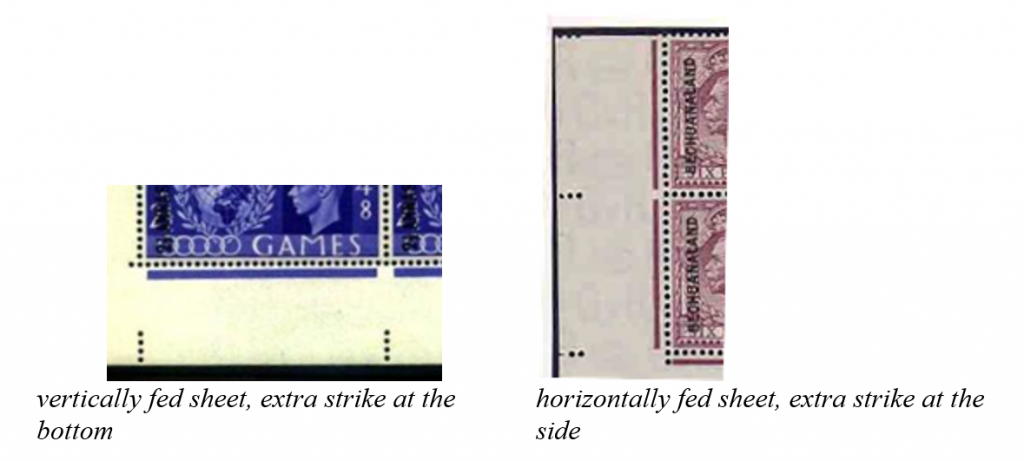
An almost pefect encroachment:
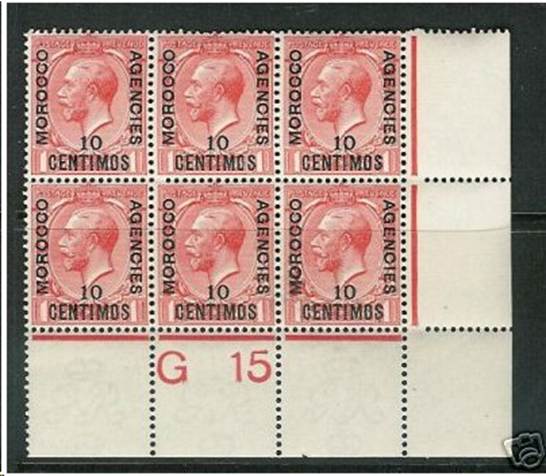
This shows an almost perfect encroachment, but the presence of the gap proves it to be perforation type “pi” rather than “pp”.
Some perfect encroachments at the bottom of the sheet create impossible perforation combinations for the issue in question.
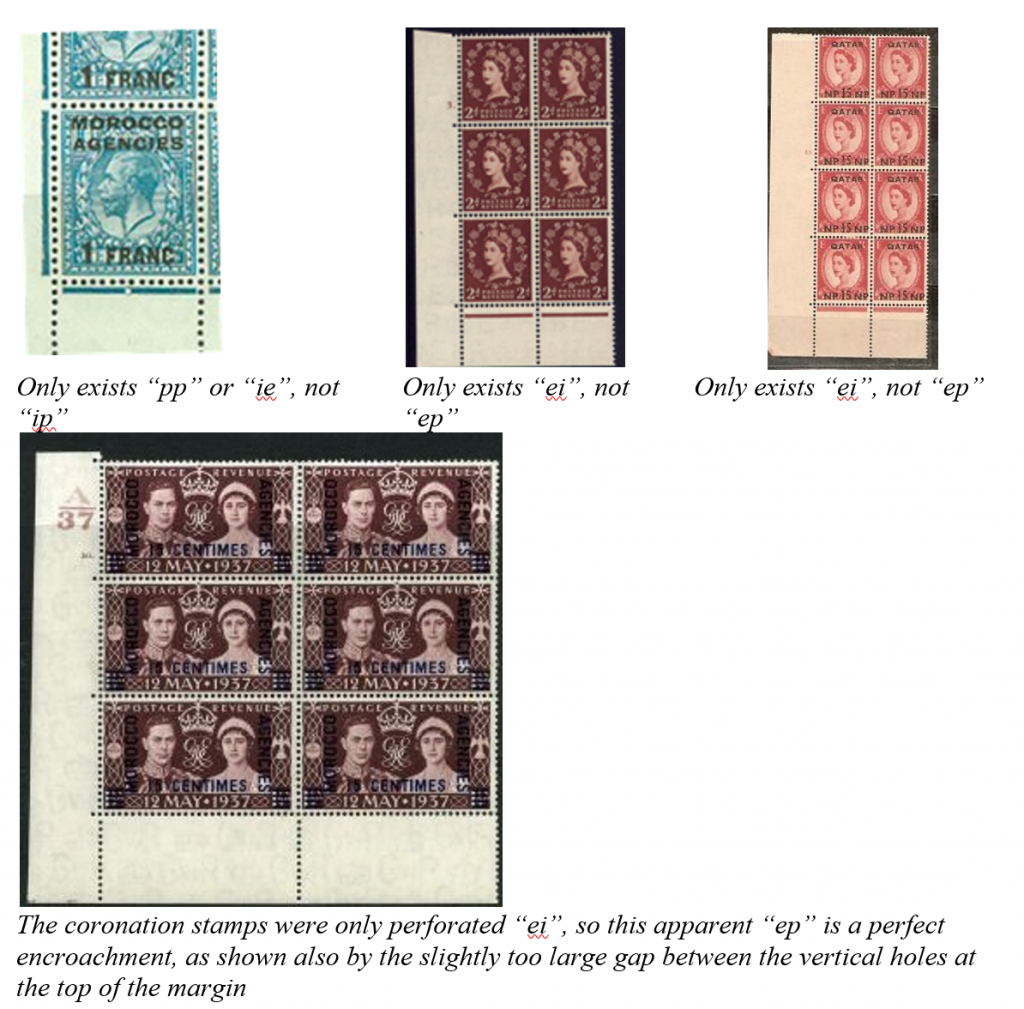
Sometimes a perforator will be realigned between rows, which can cause a perforation “jump”; these can be noticeable but are of little philatelic interest or value. For example:
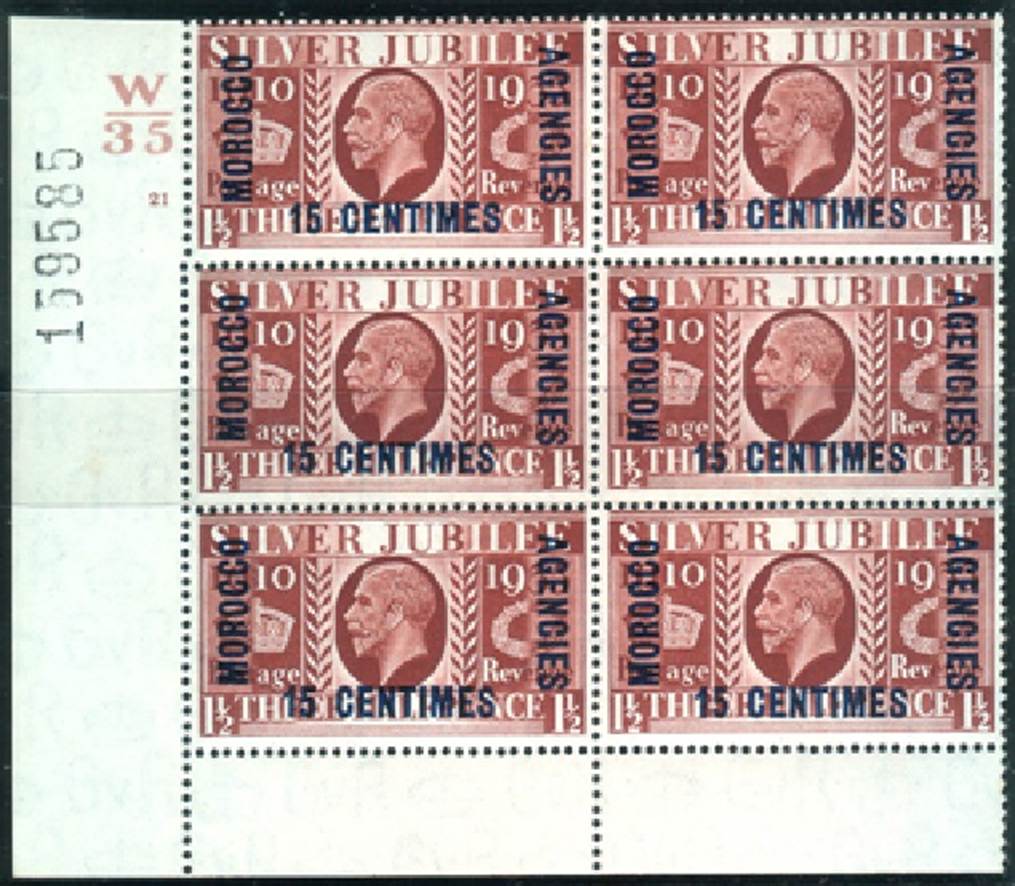
Notwithstanding the above, readers are cautioned that in some Queen Victoria issues the perforation head made a deliberate preliminary strike in the bottom margin, followed if necessary by an adjustment to make the perforator deal with the rest of the sheet properly; (xxx Ian Harvey says not) these can look like encroachments but should be properly treated as “perforated margin”, as it is a product of the layout and design of the perforating head.
The above must not be confused with perforations which go across gutters between panes in one strike; these are not caused by an extra strike but by continuous perforations across the gutter. Once the panes are separated they become marginal perforations, and the full marginal perforation description of the panes will be different. Some catalogues which describe the marginal perforation type do so in terms of the full unsplit sheet, which does not apply to the individual panes. If by chance a sheet is perforated from a different direction, or even from the back, further different combinations can be found too.
Control or cylinder at bottom left, typographed issues (no cylinder number)
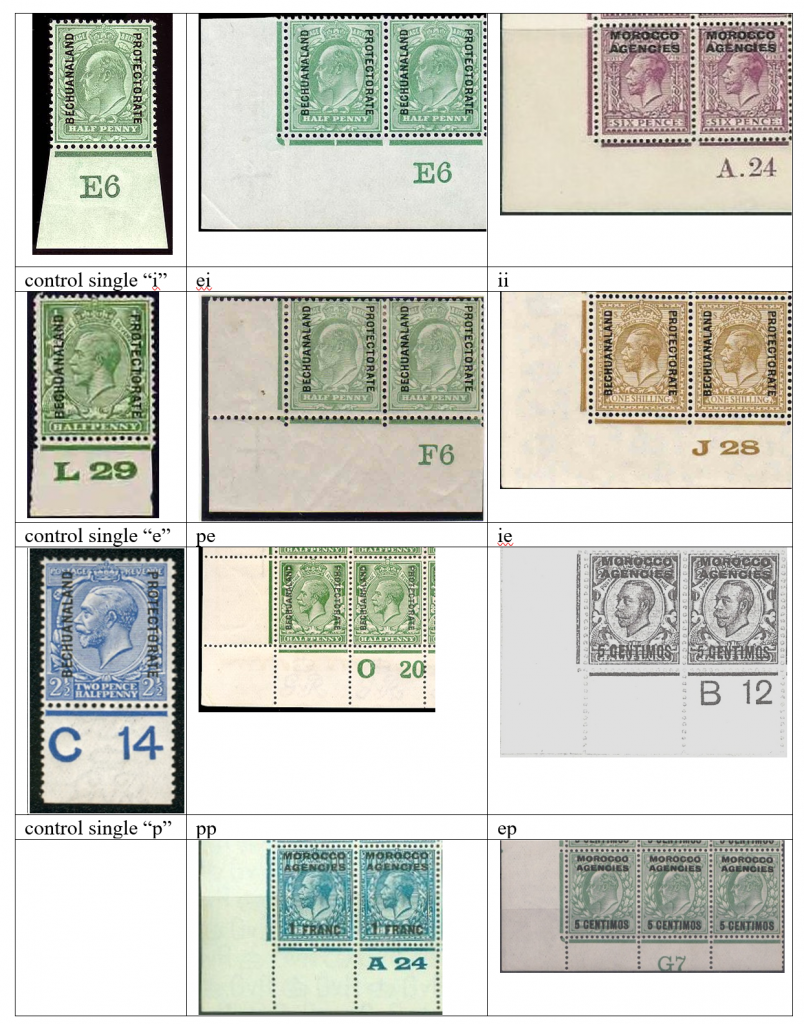
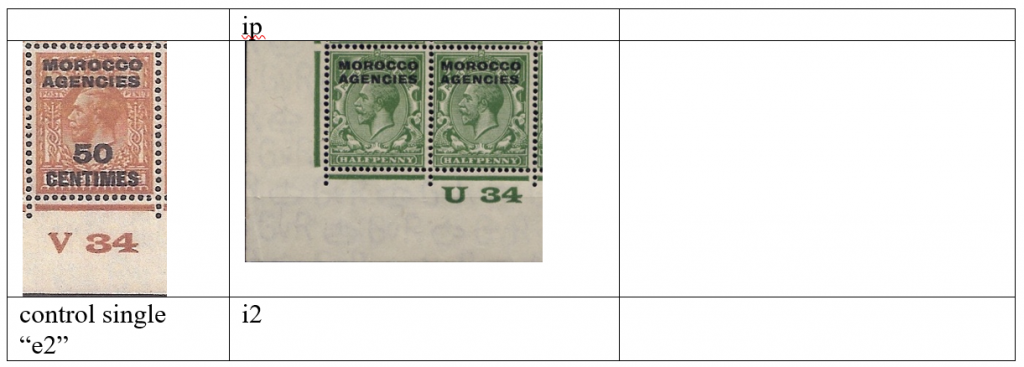
Control at bottom right, typographed issues (no cylinder number)
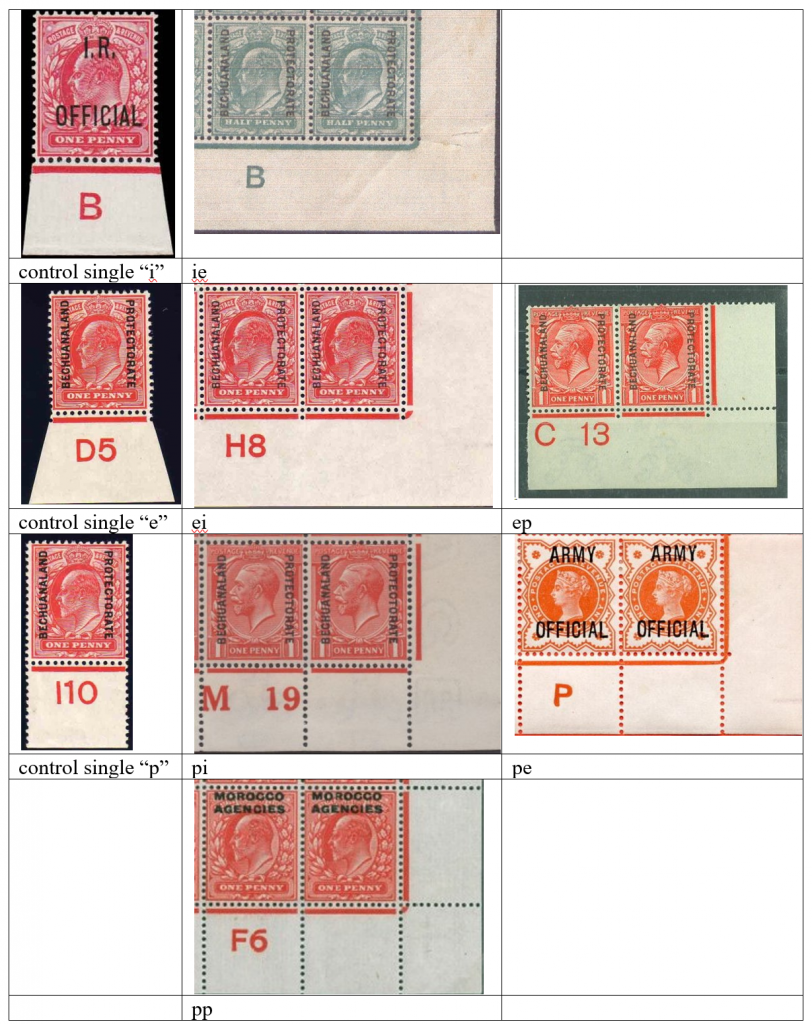
Photogravure cylinder numbers (early issues also had a control in the left margin)
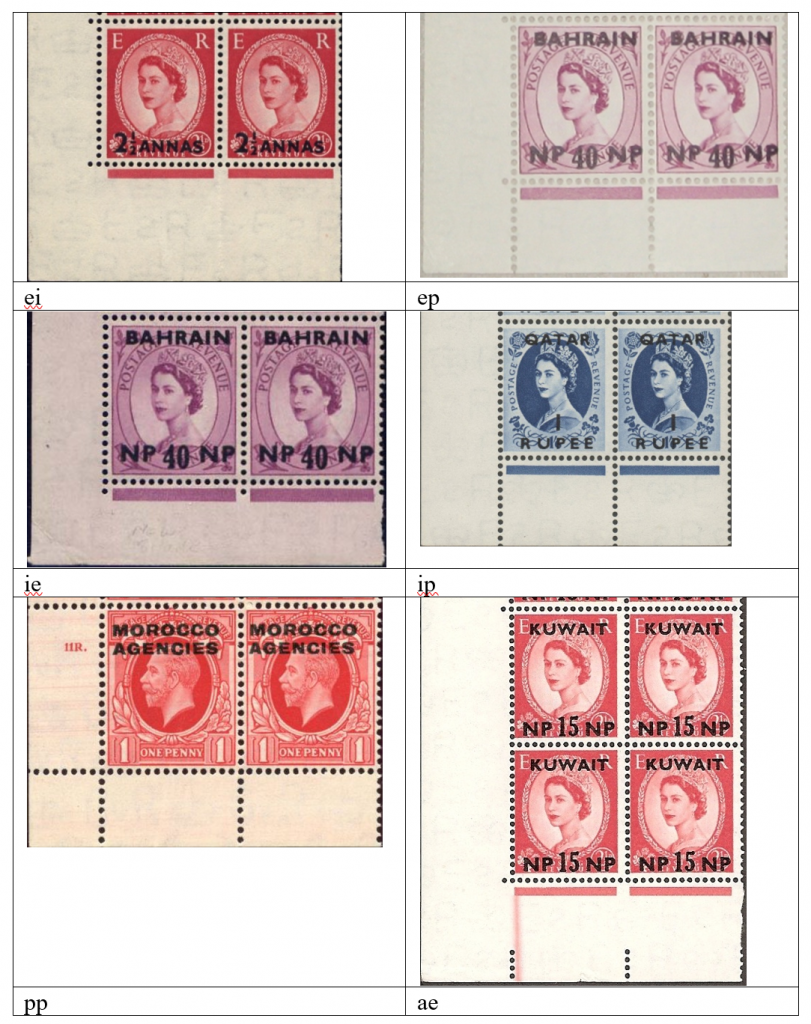
Postage dues
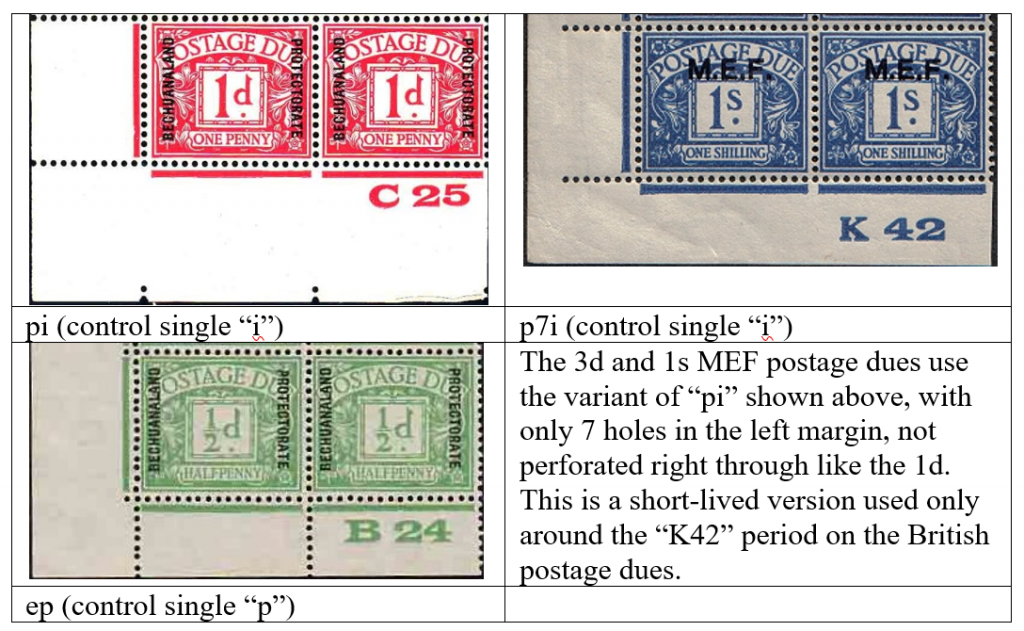
Temporary checklist

Beware of blind perfs, where the perforating pin has not fully pierced the paper, possibly due to a broken or ill-fitted pin. The blocks below are “ei” not “ae” as they were never perforated with the “ae” machine: note the non-blank extension hole on the 4th row of perforations from the bottom of the 3d, though the equivalent position on the 2d is still a blind perf. Genuine “ae” perforations were only produced in the control period N43-Q45 (and some later printings with no controls, eg 9d). The “ae” perforation type is further interesting in demonstrating that the perforator was perforating more than one row at a time.

5.1 dot pane difficulties
Sometimes the cylinder “dot” is lost in the perforation hole, making it look like a “no dot” cylinder, which has led to several ghost entries in lists. The shape of the hand-engraved cylinder number will usually show the difference correctly. Further research on this feature may lead to the removal of some “no dot” cylinders in the tables.
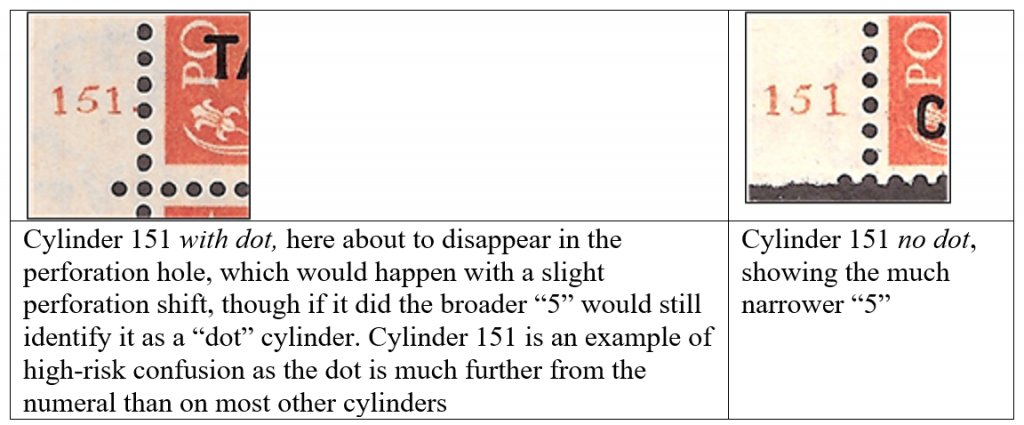
Sometimes, if the format of the cylinder number seems identical on both panes, the position of the number relative to the edge of the stamp can help confirm whether the dot has been cut off by the perforation:
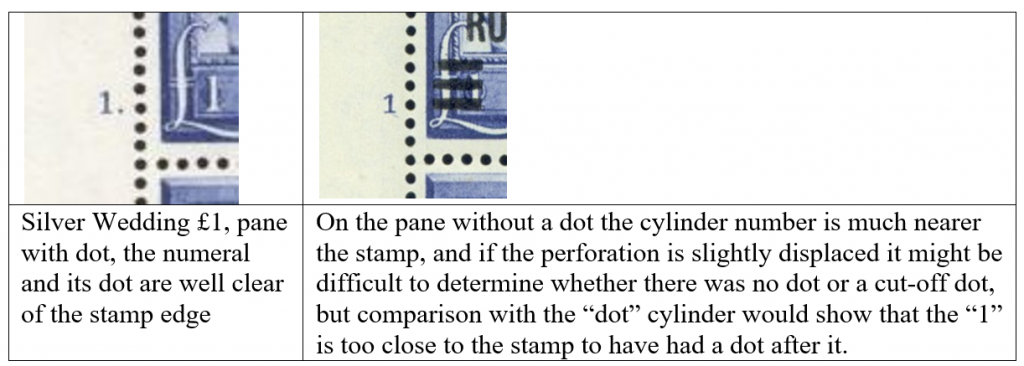
And in some cases the dot, even though well clear of the likely perforation zone, is extremely close to the number and can easily be missed:

½d 129 dot, 4d 6 dot, 1½d stamp centenary 3 dot
Some of the main cylinders (King George VI) where there is a risk of this are shown here:
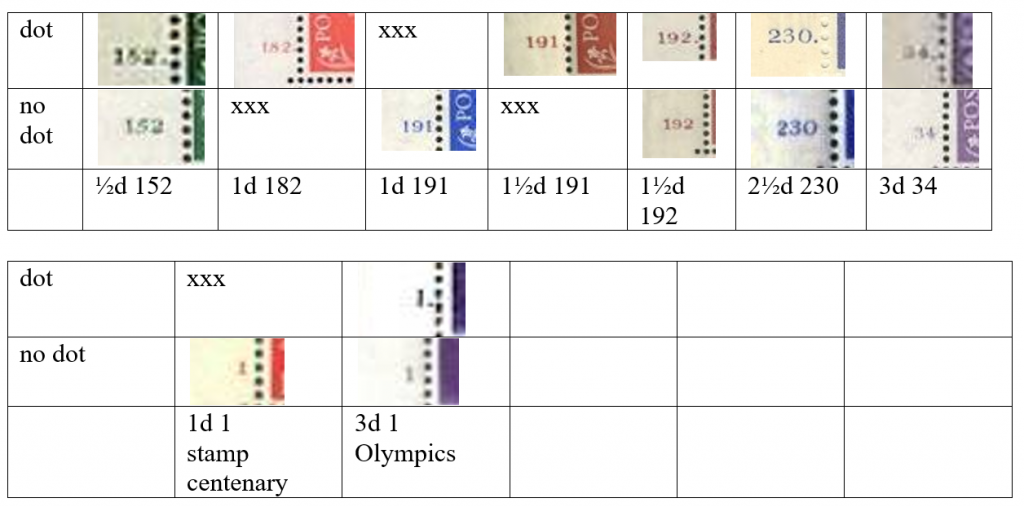
6. Cross-reference of similar sets across countries
In some cases it is informative to show the cylinders used across countries for a particular issue.
a. King George V Silver Jubilee cylinders, Morocco Agencies, 1935

Uniquely the cylinder numbers run serially through the denominations (though not in numerical order), so no cylinder number can be found on more than one value. Striking is the domination of perforation type “I/P” on the nodot panes, for which the “E/P” perforation is on the matching dot pane (though many examples offered as “E/P” are in fact “E/I” with almost perfect encroachment, as shown by the irregular adjacency of the marginal perforations – for example the apparent “E/P” commonly found on French currency 5c cylinder 55 are only found with an irregular fit, being “E/I” with an accidental extra row of perforations). The 2½d value can be found with an excellent “E/P” perforation, but alas was never used with that perforator and is “E/I” with an immaculately “perfect encroachment”.
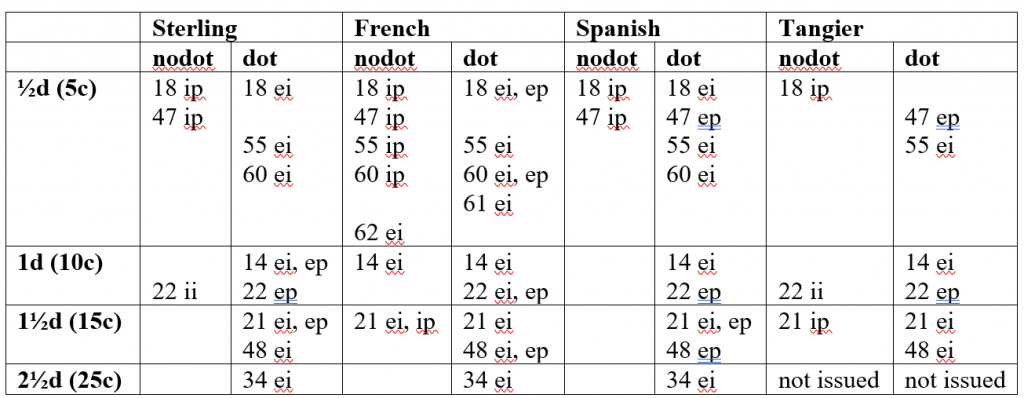
Use of cylinder numbers for the unoverprinted Silver Jubilee set
The Silver Jubilee set is unique amongst photogravure British commemorative sets in that the cylinder numbers comprise a single series across the 4 values, rather than each denomination having its own series. The cylinder number probably shows the order in which successive cylinders were made, but are spread about the denominations; this may reflect the urgency with which unexpectedly large demand led to the making of another cylinder for a particular denomination.
| Cylinder numbers in numerical order | ||||||||||
| ½d | 18, 20* | 47 | 55,60, 61, 62 | |||||||
| 1d | 14 | 22 | ||||||||
| 1½d | 2*, 7* | 21 | 27 | 48 | ||||||
| 2½d | 34 | |||||||||
* Combining the information in the two tables above it can be seen that all cylinders are known overprinted, except ½d 20 and 1½d 2, which are rare “abnormals” unoverprinted (see SG specialised). However there is no obvious reason for 1½d cylinder 7 not to have been overprinted as it is priced in the catalogues as one of the cheapest 1½d cylinders unoverprinted, though the cylinder numbers on the stocks of stamps for overprinting would normally be a pile of miscellaneous recent printings.
Perforation types of the overprinted Silver Jubilee set
The following perforation types have been recorded overprinted. All values exist in all perforation types in their unoverprinted state, except the 2½d which did not use the dual pane types 6 and 6B (marked “n/a” in the table below). The only really unexpected entry is Tangier 1½d perf 6B.
| E/I nodot (type 5) | E/I dot (type 5) | I/I nodot (type 5A) | “I/P” nodot (type 6) | “E/P” dot (type 6B) | |
| Sterling ½d | yes | yes | yes | ||
| 1d | yes | yes | yes | ||
| 1½d | yes | yes | |||
| 2½d | yes | – | – | ||
| French ½d | yes | yes | yes | yes | |
| 1d | yes | yes | yes | ||
| 1½d | yes | yes | yes | yes | |
| 2½d | yes | – | – | ||
| Spanish ½d | yes | yes | yes | ||
| 1d | yes | yes | |||
| 1½d | yes | yes | |||
| 2½d | yes | – | – | ||
| Tangier ½d | yes | yes | yes | ||
| 1d | yes | yes | yes | ||
| 1½d | yes | yes | |||
| 2½d not overprinted for Tangier | |||||
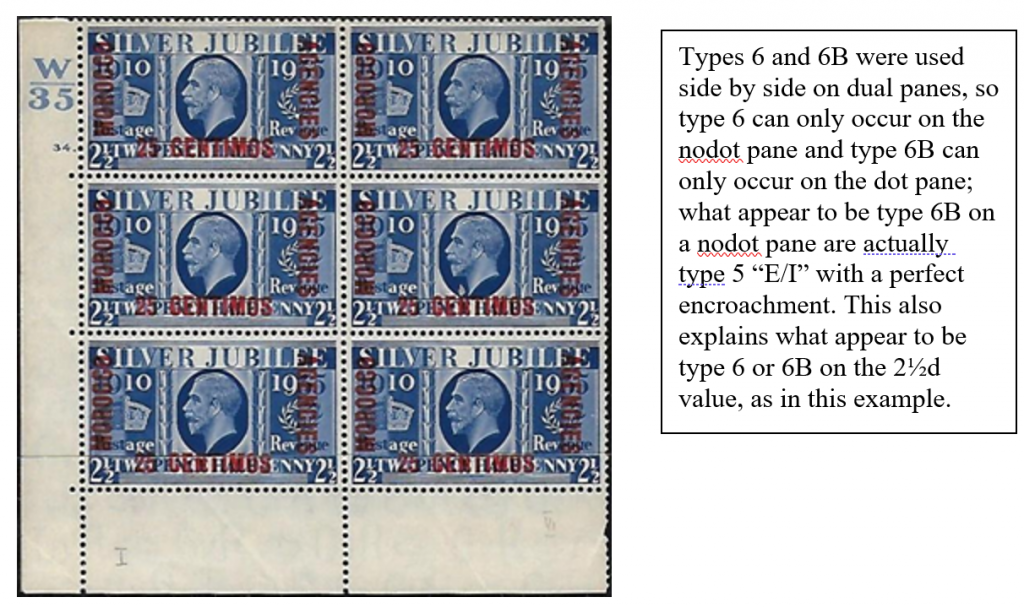
The sheets with perforation type 5A are similar to type 5 (E/I) except that the extension hole is removed at one side. On the right-hand “no dot” pane the lack of extension hole is down the left margin, giving cylinder block perforation “I/I”, and (as normal) the left-hand “no dot” pane mirrors the layout of the dot pane so the “I/I” corner is at the bottom right-hand corner. The bottom left corner of the no dot pane, like the bottom right corner of the dot pane look exactly like the corners of perforation type 5, ie imperf bottom margin and extension hole up the sides. This is the reason that Gibbons catalogues don’t list separately the dot cylinder/control block for type 5A, as there is no way of knowing whether it is type 5 or type 5A – unless of course you own the full bottom row:
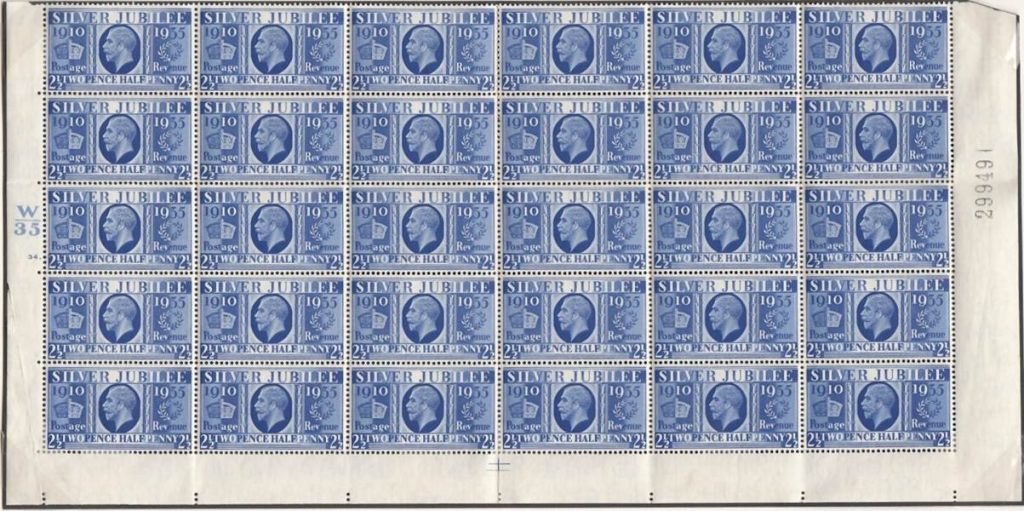
(Right-hand pane, cylinder 34 dot identical to type 5, noting the lack of extension holes both margins at the bottom right, image by kind permission of Harvey Russell)
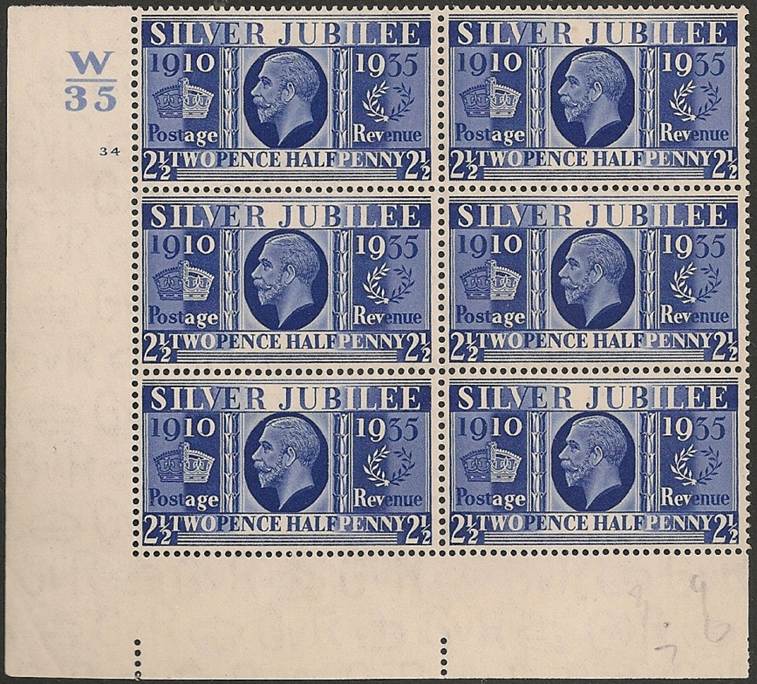
Mirror layout in the left-hand pane, cylinder 34 nodot pane, producing cylinder block type 5A “I/I”.
b. King George VI coronation cylinders, Morocco Agencies, 1937
Striking is the Tangier overprints are recorded only on the nodot pane, with the dot panes being used for the corresponding cylinders for French and Spanish currency (apart from 20 nodot for French currency). Also the plethora of plates used for the Spanish currency. British currency overprints were not issued.
| cylinder | French | Spanish | Tangier |
| 2 | dot | dot | nodot |
| 3 | dot | ||
| 6 | dot | dot | nodot |
| 7 | dot | ||
| 8 | dot | ||
| 20 | nodot | dot | |
| 23 | dot | dot | nodot |
| 30 | dot | nodot |
c. Stamp centenary cylinders, 1940 (French currency overprints were no longer in use)
| Spanish | Tangier | |||
| nodot | dot | nodot | dot | |
| ½d (5c) | 3 | 3 6 | 3 | 3 |
| 1d (10c) | 1 2 | (1 PM)* | 2 | |
| 1½d (15c) | 3 | 3 | 3 | 3 |
| 2½d (25c) | 2 5 | not issued | not issued | |
*The 1d Tangier cylinder 1 has so far only been recorded on the registration sheet in the Postal Museum.
d. Olympic Games
e. UPU
f. Silver Wedding
g. Queen Elizabeth coronation
h. Scout Jamboree
References specific to this and related chapters
GBOS GB Overprints Compendium edition 8, Dr John Gledhill (12/4/2020)
Particular thanks go to Stanley Gibbons Ltd, for permission to quote their catalogue numbers and numerous other contributors who are mentioned in the Appendix section.
All content is copyright, Dr John Gledhill and the GB Overprints Society, May 2025.






